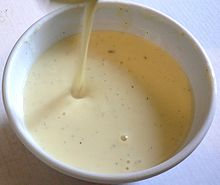Floating island (dessert)
[3][4] The earliest known English language reference to the dessert is in The Art of Cookery Made Plain and Easy (1747) by Hannah Glasse.Some scholars say that today's "Floating Island" more closely resembles the 18th century French Île Flottante than the elaborate cake and jelly constructions of English cuisine,[4] while others say that the early French versions were not made with meringue at all, but layers of liquor soaked spongecake or brioche served in custard sauce (or berry puree).[7] Elizabeth Raffald's 18th century recipe published in The Experienced English Housekeeper seeks to create a pastoral winter landscape:[7] "beat the white of an egg to a strong froth, and roll a sprig of myrtle in it to imitate snow ... let it stand till it is quite cold and stiff, then lay on rock candied-sweetmeats upon the top of your jelly, and sheep and swans to pick at the myrtle; stick green sprigs in two or three places on top of your jelly, amongst your shapes".According to Larousse Gastronomique the dessert was served a little less by the time the encyclopedia was published in 1938, and its writers expressed regret because the dish is "excellent".[8] The version recorded in the Larousse Gastronomique was made with stale Savoy biscuits sliced thin and soaked in kirsch and maraschino, layered with apricot marmalade, and a garnish of chopped almonds and currants.The layers were assembled to form a type of cake that was frosted with chantilly cream, with either custard or berry puree poured over the whole thing.
DessertFrancemeringueegg whitesvanilla extractcrème anglaiseegg yolksFood energyvanillacustardbain-marieThe Art of Cookery Made Plain and EasyHannah GlasseBenjamin FranklinFourth of JulybriocheElizabeth RaffaldThe Experienced English HousekeeperLarousse Gastronomiquekirschmaraschinochantilly creamList of custard dessertsList of dairy productsList of French desserts